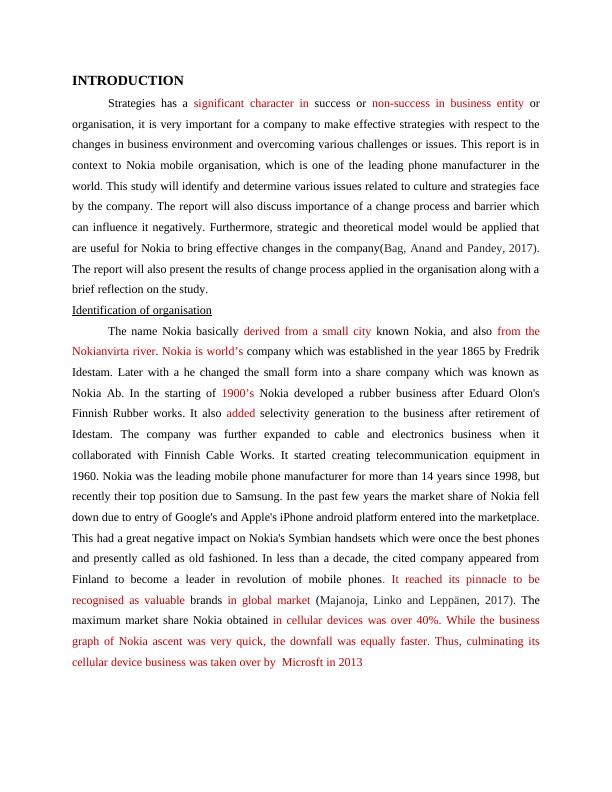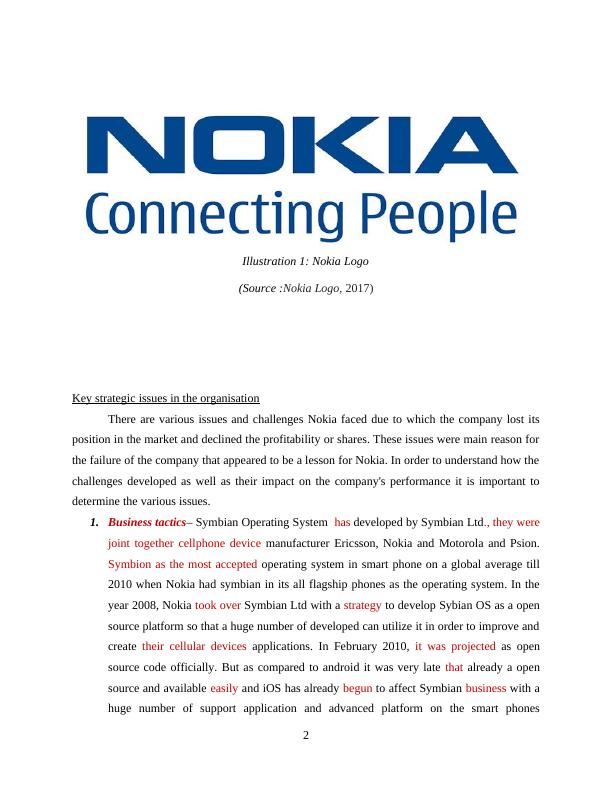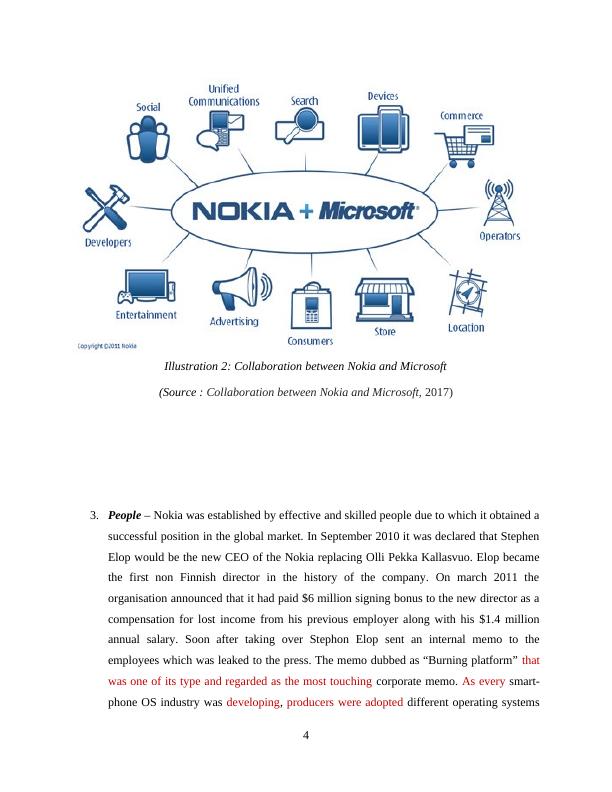Organizational Change Assignment (Doc)
Added on 2020-10-05
24 Pages8235 Words333 Views
Strategy into Action

Table of ContentsINTRODUCTION...........................................................................................................................1Identification of organization.................................................................................................1Key strategic issues in the organization.................................................................................2Rationale behind the initiation of the change process............................................................6Key stages involved in the change process............................................................................6Challenges in the change process ........................................................................................10Strategic models ..................................................................................................................10The end result.......................................................................................................................13Part 2 – Reflective Report..............................................................................................................15CONCLUSION..............................................................................................................................17REFERENCES..............................................................................................................................18

INTRODUCTIONStrategies has a significant character in success or non-success in business entity ororganisation, it is very important for a company to make effective strategies with respect to thechanges in business environment and overcoming various challenges or issues. This report is incontext to Nokia mobile organisation, which is one of the leading phone manufacturer in theworld. This study will identify and determine various issues related to culture and strategies faceby the company. The report will also discuss importance of a change process and barrier whichcan influence it negatively. Furthermore, strategic and theoretical model would be applied thatare useful for Nokia to bring effective changes in the company(Bag, Anand and Pandey, 2017).The report will also present the results of change process applied in the organisation along with abrief reflection on the study. Identification of organisationThe name Nokia basically derived from a small city known Nokia, and also from theNokianvirta river. Nokia is world’s company which was established in the year 1865 by FredrikIdestam. Later with a he changed the small form into a share company which was known asNokia Ab. In the starting of 1900’s Nokia developed a rubber business after Eduard Olon'sFinnish Rubber works. It also added selectivity generation to the business after retirement ofIdestam. The company was further expanded to cable and electronics business when itcollaborated with Finnish Cable Works. It started creating telecommunication equipment in1960. Nokia was the leading mobile phone manufacturer for more than 14 years since 1998, butrecently their top position due to Samsung. In the past few years the market share of Nokia felldown due to entry of Google's and Apple's iPhone android platform entered into the marketplace.This had a great negative impact on Nokia's Symbian handsets which were once the best phonesand presently called as old fashioned. In less than a decade, the cited company appeared fromFinland to become a leader in revolution of mobile phones. It reached its pinnacle to berecognised as valuable brands in global market (Majanoja, Linko and Leppänen, 2017). Themaximum market share Nokia obtained in cellular devices was over 40%. While the businessgraph of Nokia ascent was very quick, the downfall was equally faster. Thus, culminating itscellular device business was taken over by Microsft in 2013

Key strategic issues in the organisationThere are various issues and challenges Nokia faced due to which the company lost itsposition in the market and declined the profitability or shares. These issues were main reason forthe failure of the company that appeared to be a lesson for Nokia. In order to understand how thechallenges developed as well as their impact on the company's performance it is important todetermine the various issues. 1.Business tactics– Symbian Operating System has developed by Symbian Ltd., they werejoint together cellphone device manufacturer Ericsson, Nokia and Motorola and Psion.Symbion as the most accepted operating system in smart phone on a global average till2010 when Nokia had symbian in its all flagship phones as the operating system. In theyear 2008, Nokia took over Symbian Ltd with a strategy to develop Sybian OS as a opensource platform so that a huge number of developed can utilize it in order to improve andcreate their cellular devices applications. In February 2010, it was projected as opensource code officially. But as compared to android it was very late that already a opensource and available easily and iOS has already begun to affect Symbian business with ahuge number of support application and advanced platform on the smart phones2Illustration 1: Nokia Logo(Source :Nokia Logo, 2017)

(Ciesielska, 2017). On February 11, 2011 Nokia declared its partnership with Microsoftand developed their operating for example Windows OS in their smart-phones. Aresearch in June 2011 showed that over 39% of the mobile developers utilizationSymbian had planned to discard the platform for either IOS or Android. Nokia then madewith Accenture for Sybian based support services and software development through2016 that also saw 2800 employees of Nokia moving to Accenture.2.telecommunication– Nokia being leaders in telecommunication cellphones and mobiles,it took time for the start upfor the company to achieve that position but just because ofaging technology and staff it failed to sustain its place in the intense market competition.They developed a Mobile series from 1982 to 1990 which was most popular during thatperiod. From 1990 to 1999 Nokia sold the original series of phones including the latestcreated GSM technology. Later Nokia started developing digital camera phones, colorscreen phones and music capable phones. The company also had a series of gamingphones which were sold highly and were very popular among teenagers. Indirectly theytook over Apple's iPod, Sony's walkman and market share of other related products.Again Nokia came up with business series phones which has various corporate befittingfeatures such as push email. They utilized Symbian OS and were leading all over theworld with their impressive smart feature phones (Coccia, 2018). However, the companyhad reached the peak of its development and research cycles. They needed to design andimplement new technology to continue and sustain the leading position in the market butthey failed to do so as compared to their competitors Apple and Google who introducedAndroid and iOS operating systems (Lasserre, 2017). Nokia believed that its oldoperating system is capable to compete with phones with new technology but later thecompany realized that it is not possible and started seeking for development of a newoperating system. Then it started looking for a new partner with advance hardware todevelop a new product that can be successful in the market. Nokia collaborated withMicrosoft for its mobile platform OS Windows 7.5 mango and launched the Lumia serieswhich consisted advanced hardware. But till that time Nokia already lost its strongposition in the market as competitors such as Samsung and Apple already acquired ahuge market share.3

3.People – Nokia was established by effective and skilled people due to which it obtained asuccessful position in the global market. In September 2010 it was declared that StephenElop would be the new CEO of the Nokia replacing Olli Pekka Kallasvuo. Elop becamethe first non Finnish director in the history of the company. On march 2011 theorganisation announced that it had paid $6 million signing bonus to the new director as acompensation for lost income from his previous employer along with his $1.4 millionannual salary. Soon after taking over Stephon Elop sent an internal memo to theemployees which was leaked to the press. The memo dubbed as “Burning platform” thatwas one of its type and regarded as the most touching corporate memo. As every smart-phone OS industry was developing, producerswere adopted different operating systems4Illustration 2: Collaboration between Nokia and Microsoft(Source : Collaboration between Nokia and Microsoft, 2017)

End of preview
Want to access all the pages? Upload your documents or become a member.
Related Documents
Challenges Faced by Nokia: A Management Perspectivelg...
|11
|2675
|54
The Role of Customer Feedbacks on Product Quality of Nokia Companylg...
|12
|2622
|96
Why Did Nokia Fail in the Global Smartphone Industry?lg...
|9
|2940
|455
Business External and Micro Economic Environmentlg...
|13
|3685
|73
Sustainable Enterprise and Social Responsibilitylg...
|20
|4935
|151
Nokia Company: History, Analysis, and Business Overviewlg...
|9
|1804
|94
